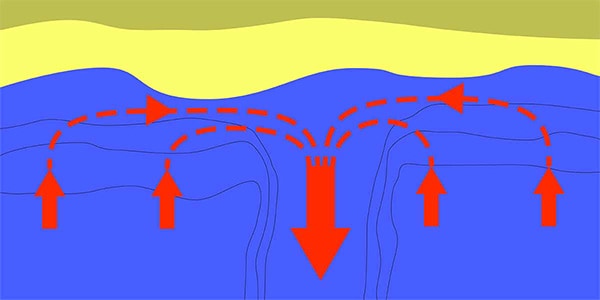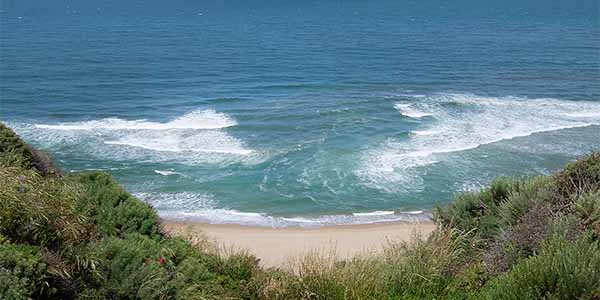Rip Tide vs Rip Currents – All You Need To Know
The terms “Rip Tide” and “Rip Current” are often used interchangeably, but they actually describe two completely different phenomena.
“A rip tide is a strong offshore current, powered by predictable tidal forces. Rip tides are caused when a regular tide runs through a constricted area such as the entrance to a bay or a port. To move the same volume of water through a narrower gap, it speeds up.”
Casual Navigation
“A rip current is a strong, narrow current of water that flows directly away from the shore. Rip currents are powered by wave action and are often identified as a gap between breaking waves, where you can observe the water flowing away from the shore.”
Casual Navigation
When people discuss rip tides and rip currents, they are usually getting confused by the similar-sounding terms and actually just mean “rip current”.
Rip currents are the ones that you see signposted at beaches, warning you that there might be currents present that could sweep you out to sea.

When you get caught in a rip current, you should relax and then swim at right angles to the current until you get clear.
Rip tides, on the other hand, are predictable strong offshore currents that are powered by the tidal forces caused by the moon and the sun’s gravity.
They usually flow in one direction during the flood tide and the opposite direction during the ebb tide.
When a tide flows through a constricted area, the only way to get the entire volume of water through is for it to speed up.
A rip tide is simply a tide that is moving fast through a constricted area.
Do you enjoy learning about the tide? Check out this full article next: 20 Types Of Tide: Explained By A Real Ship’s Officer.
What is a rip current?
A rip current is a strong, narrow current of water that flows directly away from the shore. Rip currents form in areas of the seabed with uneven topography, where a narrow section offers a path-of-least-resistance for water to flow away.

In the diagram above, you can see that a rip current has formed in a channel that is deeper than the surrounding seabed.
When waves break along the coastline, they bring water high up the beach. As the wave recedes, the water wants to flow back to the sea.
If the coastline is uniform, water flows back evenly, meeting the next incoming wave.
When the topography offers a different route, as you can see in the diagram above, the water seeks the path of least resistance instead.
To feed water into the rip current, feeder currents run along the beach as the water flows towards the deeper channel.
The rip current then takes the water straight down the channel, perpendicular to the shoreline until it is clear of the waves that are powering it.
Rip currents are only really dangerous when they are unexpected.
An unexpected rip current will quickly exhaust a panicked swimmer, but that same current could be a welcome relief to surfers wanting an easy route back out to where the breakers form.
Pro Tip: Rip currents are narrow so if you are caught unexpectedly, swim at right angles to escape.
How to identify a rip current
Rip currents form when water flows up a beach in breaking waves but flows out through a deeper, narrow channel.
As such, the easiest way to spot a rip current is as a gap between breaking waves.

In the image above, you can see the breaking waves on either side of the current which is bringing water up the beach.
The current is clearly visible in the middle due to the absence of breaking waves, and the froth that gets dragged along with the water flow.
Water is flowing away from the shore at such a rate that it dampens the incoming waves while sucking aerated water away, resulting in the streaks of froth that you can see leading away from the beach.
Occasionally, a rip current may be powered by waves that are not breaking. If this happens, the rip will show itself as a narrow line of waves breaking away from the shoreline instead.
What to do if you are caught in a rip current
If you are swimming and get caught in a rip current, the first thing you should do is relax.
DO NOT TRY TO SWIM AGAINST THE CURRENT.
If you have the strength, swim parallel to the shoreline, at right-angles to the direction of the current.
Rip currents are usually narrow, so you should be able to swim clear relatively quickly.
Alternatively, you can just let the rip current carry you away from the shore until it dissipates.
Just concentrate on floating on the surface, while trying to get the attention of someone on the shoreline.
Rip currents generally do not run a long distance from the shore, so you can wait until it eases and then simply look for an inbound current to carry you back in.

Your goal is to get out of the current taking you away from the shore, and into the currents that are flowing back in.
Rip currents are not dangerous, as long as you are expecting them and know how to deal with them.
In fact, some people will search out rip currents for fun.
For example, a surfer might use a rip current to hitch a ride back out, beyond the breaking waves.
What is a rip tide?
A rip tide is a strong offshore current, powered by the tide. They typically run in areas where a large volume of water needs to move through a small opening between high tide and low tide.
For example, a rip tide might run through the narrow opening of a port or lagoon during both the flood and the ebb tide.
As they are powered by tidal forces, rip tides are predictable, often changing direction as the tide turns from the flood to the ebb.
Their strength depends on the strength of the tide, so it usually increases during spring tides and reduces during neap tides.
Find out more about spring and neap tides: What Is The Difference Between Spring & Neap Tides?
How to identify a rip tide
As they are predictable tidal flows, rip tides are easily identified using a tidal stream atlas, nautical chart, or other sources of tidal information.
They will tend to flow strongest halfway through the tide, between high water and low water.

As you can see from the sample tidal curve, the greatest tidal flow occurs halfway between high water and low water, when the curve is the steepest.
Conversely, during slack water, rip tides do not run.
Read more: When Is Slack Tide?
Identification of rip tides should form a part of your passage planning process before you go out boating.
Once identified, you can use them to your advantage, not only to keep yourself safe but also to save yourself considerable expenses on fuel.
What to do if you are caught in a rip tide
There are two primary scenarios when you might get caught in a rip tide: in a boat; or when you are swimming.
In both situations, the primary thing to remember is that the rip tide should not pull you under the water, but it will drag you along.
In a boat, you may well have planned to be caught in a rip tide as an intentional part of your passage.
Tides can be incredibly useful when you are boating, as I discussed in another article: How Do Tides Affect Boats?
As an example, if you are leaving a harbour with a known rip tide, it makes sense to leave when the tide is ebbing so that it will help you on your way out.
Similarly, if you are transiting along a coastline and there is a known rip tide, you should plan to be travelling in the same direction as the tide.
Should the tide turn and catch you out, however, there are a few actions you can take.
If you have the power in your engines, you could just increase your speed through the water and keep going.
Alternatively, you might consider dropping your anchor and waiting for the tide to turn.
As rip tides are powered by tidal forces, they should turn every 6 hours.
If you get caught in a rip tide while you are swimming, however, things will be very different.
As with the rip current, you should never try to swim against a rip tide.
Instead, concentrate on staying afloat, shouting and waving your hands to attract attention if you can.
Rip tides can be many miles wide, so only try to swim perpendicular to the current if you can see somewhere safe to swim to.
Otherwise, your priority should be staying afloat, waiting until you get swept clear of the tide.
What is the difference between a rip tide and a rip current?
There are a number of differences between rip tides and rip currents that we should be aware of.
| Rip Tide | Rip Current |
|---|---|
| Driven by the tide | Driven by wind and waves |
| Predictable | Unpredictable |
| Generally wide | Can be short & narrow |
| Hard to escape | “Easy” to escape |
| Generally don’t form in lakes | Can form in lakes |
| Direction changes every 6 hours | Consistent directionality |
The primary difference between a rip tide and a rip current is that a rip tide is a “tide”, powered by the tidal forces of the moon and the sun’s gravity, while a rip current is a current that forms due to wind and wave action.
Rip currents form on the shoreline when the action of wind or waves moves water up a non-uniform beach. As the water moves back out, it will take a path-of-least resistance (if available) forming a rip current.
Conversely, rip tides form further out when a tidal flow is constricted, for example by a harbour entrance or a headland. Due to the constriction, the water flow speeds up so that the same volume of water will fit through a smaller gap.
In terms of predictability, rip tides are far more predictable than rip currents.
As they are powered by regular tidal forces, rip tides follow the same predictable pattern as the tides.
Rip currents, on the other hand, are powered by wind and wave action, so are much less predictable.
Given tip tides are powered by tidal forces, it stands to reason that they are most prevalent in highly tidal areas. You are unlikely, for example, to find a rip tide on a lake.
Read more: Do Lakes Have Tides?
Even though lakes do not have noticeable tides, rip currents can still form as they are powered by wind and waves instead.
Assuming the topography of the lake bed is correct, with the right conditions, it is perfectly possible for rip currents to form.
This is why you may see signs at a lake telling you to beware of rip currents,
Do rip tides or rip currents pull you underwater?
Rip tides and rip currents will not usually pull you underwater.
They are both a lateral movement of water, rather than currents moving straight down.
Anything floating in the moving body of water should continue to float, even though it is being dragged along.
As such, if you are caught in a rip tide or a rip current, your primary survival technique should be to simply tread water and continue to float, waiting until the current dissipates.
Although it might appear that you are travelling at a high-speed relative to the land, you are not moving within the water body.
The entire water body is moving, taking you along with it.
Never waste your energy swimming against the direction of flow.
